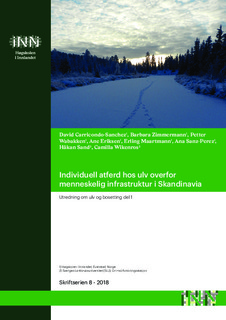Individuell atferd hos ulv overfor menneskelig infrastruktur i Skandinavia: Utredning om ulv og bosetting del 1
Carricondo-Sanchez, David; Zimmermann, Barbara; Wabakken, Petter; Eriksen, Ane; Maartmann, Erling; Sanz Perez, Ana; Sand, Håkan; Wikenros, Camilla
Research report
Permanent lenke
http://hdl.handle.net/11250/2587279Utgivelsesdato
2019Metadata
Vis full innførselSamlinger
Sammendrag
Ulv er kjent for å være en habitatgeneralist med ynglende bestander i mange ulike typer habitat fra arktiske strøk, boreale skoger, åpne landbruksområder og til tettbefolkede områder i varme strøk. En viktig faktor for ulvens habitatvalg er tilgang til byttedyr, og flere studier har vist at i områder hvor menneskelig infrastruktur overlapper med tilgang til byttedyr, utnytter ulven natten for å jakte. Ikke bare ytre faktorer kan påvirke ulvers habitatvalg. Ulveindivider har ulik personalitet formet av nedarvede og lærte egenskaper, og det kan derfor forventes en stor variasjon i hvordan ulike individer oppfører seg overfor menneskelig infrastruktur. Vi kategoriserte Skandinaviske ulvers individuelle atferd langs en gradient fra unnvikende til oppsøkende, der unnvikende betyr unngåelse av infrastruktur og oppsøkende betyr preferanse for eller større bruk av infrastruktur enn forventet fra tilgjengeligheten. Vi brukte GPS-posisjoner fra 55 forsknings- og forvaltningsmerkede ulver i tidsperioden 2001-2017 i individuelle stegvalganalyser for å beskrive habitatvalget for hvert individ, for deretter å teste om variasjonen i habitatvalget kan forklares med årstid, tid på døgnet, alder, kjønn og andre individ- og revirspesifikke egenskaper.
Ulvene viste oftest ikke noe spesielt seleksjonsmønster eller var unnvikende overfor infrastruktur, og oppsøkende atferd var sjeldent, med et unntak: mer enn halvparten av ulvene viste en oppsøkende atferd overfor skogsbilveier, trolig for bruk til energieffektiv forflytning. Ulvene foretrakk områder med veldig lav bygningstetthet. På dagtid var ulvene mer unnvikende, trolig for å unngå møter med folk, og på natten var de mindre unnvikende eller mer oppsøkende, trolig for å jakte på byttedyr. Ulvene, og spesielt tispene, var mer unnvikende på sommeren, trolig for å skjerme valpene på hi- og valpeplassene fra menneskelig forstyrrelse. Om vinteren var ulvene mindre unnvikende eller mer oppsøkende, trolig for å jakte elg og rådyr som oppholdt seg nær menneskelig infrastruktur når det er snødekke. Ulvene nord i norsk ulvesone og tilgrensende områder var mer oppsøkende enn ulvene lenger sør, trolig som en effekt av elgfordelingen i dalbunnene vinterstid i områder med elgtrekk. Vi fant ikke noen tydelig effekt av ulike individers eller flokkers særegenhet på deres atferdsmønster og antar derfor at ulvene i Skandinavia utviser en stor grad av fleksibilitet og tilpasningsevne i deres atferd overfor menneskelig infrastruktur. English: The wolf is a habitat generalist with reproducing populations in a variety of habitats from arctic areas, vast boreal forests, open agricultural areas to densely populated areas in the subtropics. An important factor for wolf habitat selection is the availability of prey, and several studies have shown that wolves utilize the dark hours for hunting in areas where human infrastructure overlaps with the access to prey. Not only extrinsic factors can affect wolf habitat selection. Wolf individuals have different personalities that are formed by inherited and learned traits. We therefore expect a large variation in individual behavior in relation to human infrastructure. We categorized the behaviour of Scandinavian wolves along a gradient from elusive to bold, elusive describing situations where wolves avoid human infrastructure, and bold for preference of infrastructure or higher use than expected from availability. For this, we used GPS-positions of 55 wolves radio-collared by the Scandinavian Wolf Research Project SKANDULV or the management during 2001-2017 in individual step selection functions to describe habitat selection for each individual. In a second step, we tested if the observed variation in habitat selection can be explained by season, time of day, age, sex and other characteristics specific to the individuals or the territory.
The studied wolves were mostly non-selective towards or avoided human infrastructure and only rarely preferred infrastructure, with one exception: More than half of the wolves preferred close distances to forest roads, truly for energy-efficient travelling. The wolves preferred areas with very low density of buildings. They were more elusive during daytime, truly to avoid human disturbance, and less elusive or bolder in the night, truly to hunt for prey. The wolves, and in particular the females, were more elusive during summer, truly to protect the pups at the den and rendezvous sites from human disturbance. In winter, wolves were less elusive or bolder, truly during search for moose and roe deer which can concentrate close to settlements in times of snow cover. The wolves north in the Norwegian wolf zone and adjacent areas were bolder than wolves further south, truly as an effect of moose concentrations in the valley bottoms in areas with seasonally migrating moose populations. We could not find distinct effects of individual- or pack-specific characteristics on the behaviour towards human infrastructure, and we therefore assume that wolves in Scandinavia have a high degree of behavioural flexibility and adaptability in relation to human infrastructure.
